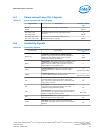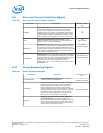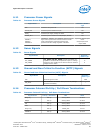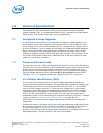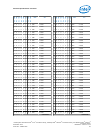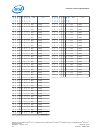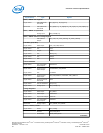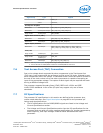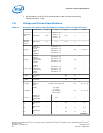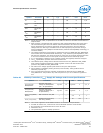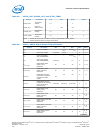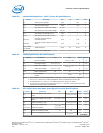
Reserved or Unused Signals
The following are the general types of reserved (RSVD) signals and connection
guidelines:
• RSVD – these signals should not be connected
• RSVD_TP – these signals should be routed to a test point
• RSVD_NCTF – these signals are non-critical to function and may be left un-
connected
Arbitrary connection of these signals to VCC, VDDQ, VSS, or to any other signal
(including each other) may result in component malfunction or incompatibility with
future processors. See Signal Description on page 82 for a pin listing of the processor
and the location of all reserved signals.
For reliable operation, always connect unused inputs or bi-directional signals to an
appropriate signal level. Unused active high inputs should be connected through a
resistor to ground (VSS). Unused outputs maybe left unconnected; however, this may
interfere with some Test Access Port (TAP) functions, complicate debug probing, and
prevent boundary scan testing. A resistor must be used when tying bi-directional
signals to power or ground. When tying any signal to power or ground, a resistor will
also allow for system testability.
Signal Groups
Signals are grouped by buffer type and similar characteristics as listed in the following
table. The buffer type indicates which signaling technology and specifications apply to
the signals. All the differential signals and selected DDR3/DDR3L and Control Sideband
signals have On-Die Termination (ODT) resistors. Some signals do not have ODT and
need to be terminated on the board.
Note: All Control Sideband Asynchronous signals are required to be asserted/de-asserted for
at least 10 BCLKs with maximum Trise/Tfall of 6 ns for the processor to recognize the
proper signal state. See the DC Specifications section and AC Specifications section.
Table 46. Signal Groups
Signal Group Type Signals
System Reference Clock
Differential CMOS Input BCLKP, BCLKN, DPLL_REF_CLKP, DPLL_REF_CLKN,
SSC_DPLL_REF_CLKP, SSC_DPLL_REF_CLKN
DDR3 / DDR3L Reference Clocks
2
Differential DDR3/DDR3L
Output
SA_CKP[3:0], SA_CKN[3:0], SB_CKP[3:0], SB_CKN[3:0]
DDR3 / DDR3L Command Signals
2
Single ended DDR3/DDR3L
Output
SA_BS[2:0], SB_BS[2:0], SA_WE#, SB_WE#, SA_RAS#,
SB_RAS#, SA_CAS#, SB_CAS#, SA_MA[15:0], SB_MA[15:0]
DDR3 / DDR3L Control Signals
2
Single ended DDR3/DDR3L
Output
SA_CKE[3:0], SB_CKE[3:0], SA_CS#[3:0], SB_CS#[3:0],
SA_ODT[3:0], SB_ODT[3:0]
Single ended CMOS Output SM_DRAMRST#
continued...
7.4
7.5
Electrical Specifications—Processor
Desktop 4th Generation Intel
®
Core
™
Processor Family, Desktop Intel
®
Pentium
®
Processor Family, and Desktop Intel
®
Celeron
®
Processor Family
December 2013 Datasheet – Volume 1 of 2
Order No.: 328897-004 95



